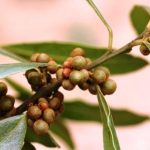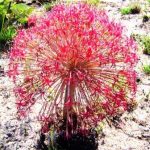TREE LIFE
February 2006
Please note that with immediate effect the post office box number for the Tree Society has changed to:
P.O. BOX A 273 AVONDALE HARARE
MASHONALAND CALENDAR
Saturday and Sunday 4th and 5th February: City Garden Club’s Summer Show. Saturday 4th 12 noon to 5pm and Sunday 5th from 9 to 12am.
On show will be roses, dahlias, etc. container plants, an exhibition of photographs and paintings. There will also be raffles, a mini market, and indigenous trees for sale. Refreshments will be available and there will be plenty of secure parking. Entrance charge – Adults $60 000, pensioners $40 000 and children $20 000.
Tuesday 14th February: Please note the change of date to the second Tuesday just for this month. Botanic Garden Walk. Meet Tom in the car park at 4.45 for 5 pm. Tom will continue with the family Combretaceae.
Sunday 19th February.
Because of the holidays the venue for February’s outing is still to be confirmed. The details will be emailed to all members. Those receiving a printed Tree Life please phone Mark, Terry or Maureen for the details if you wish to join the group.
Saturday 25th February: Mark’s Walk will be at St. George’s College, (to see the little terrestrial orchid – Disperis in flower) Meet in the car park near the squash courts at 2.30pm.
After the success of the previous ‘Show and Tell’ evening it is hoped it will become a regular event, say every three months. If you have slides (any topic) or some computer pictures, or anything that would interest other members please bring them along. Once again it will be held at Adele’s house at No. 3 Normandy Close Alex Park.
Supper will be a bring and share arrangement. Further details in the March Tree Life.
MATABELELAND CALENDAR
Please contact Jean Wiley or Gill Short for details of the next Matabeleland function.
SUBSCRIPTIONS FOR 2006/7
Once again, I am writing, as Chairman, to inform members of the Society’s subscriptions for the year from 1 April 2006 to 31 March 2007.
We discussed this, as we usually do, at our January Committee meeting and as so often in previous years, a difficult decision lay before us. The move to an email-based system has certainly saved the Society some money, but on the other hand, we do not want to let our income wither away completely. We therefore decided upon on a 400% increase, which is likely to be lower than “headline” inflation by March, but is obviously still a fairly horrific increase.
All the classes of subscriptions were increased by a factor of 5 and became as follows:
Email Z$160,000
Printed copy: collected Z$320,00
Printed copy: posted Z$800,00
Once again, I must emphasize strongly that we do not want to lose members as a result of these increases. Each year a number of members pay more than the norm so that the excess goes anonymously to support members who may be having financial difficulties. So, please do not be proud; talk to Maureen, Terry or me.
Mark Hyde
BOTANIC GARDEN WALK: 6TH NOVEMBER 2005
COMBRETACAE: PART 1
Tom’s subject today was Combretaceae. Accordingly to Mabberley, this family has 500 species and is widespread in tropical and warm regions of the world, especially Africa. Certainly, it is a very important constituent of Zimbabwe’s vegetation.
What can we say about this family? The features may be briefly summarised as follows:
- predominantly woody, consisting mostly of trees, shrubs or woody climbers; even the species which are small and have herbaceous stems are mostly suffrutices arising from a woody underground rhizome.
• the leaves are simple, but may be opposite, whorled, subopposite or alternate;
• the leaves are almost always entire;
• the indumentum of scales and/or hairs is taxonomically distinctive (although microscopic);
• there are no stipules;
• the flowers may be bisexual or unisexual;
• the flowering parts (sepals, petals, stamens etc.) are usually in multiples of 4 or 5 (but sometimes, e.g. in Terminalia, the petals may be absent);
• the ovary is inferior with 1 chamber (and hence the fruits are 1-seeded);
• the fruits are winged with usually 2, 4 or 5 wings.
There are 4 genera: Combretum (the largest by number of species), Terminalia, the next largest, and two small genera, namely Pteleopsis (2 species) and Meiostemon (1 species only).
In general, the family is quite recognizable in the field, although confusion between Combretum and Schrebera trichoclada, which also has simple, opposite leaves is possible.
Although many species are clearly defined, there are taxonomic difficulties in Terminalia and of course identifying material without flowers or fruits can be very challenging.
The following is a series of notes about each genus and species. It mainly reflects Tom’s comments, supplemented by information from Coates Palgrave (both the book and Meg herself!) and Flora Zambesiaca. Naturally, I have left out much additional useful information.
Our first port of call was in the small genus Pteleopsis.
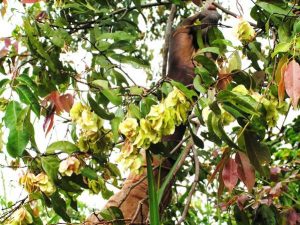
Pteleopsis anisoptera. Photo: Jos Stevens. Source: Flora of Zimbabwe
There are two species Pteleopsis anisoptera (the Four-winged stink-bushwillow) and Pteleopsis myrtifolia, (the Two-winged stink-bushwillow). Tom remarked that these are quite closely related (the account in FZ mentions intermediates which may be hybrids) but are generally easy to separate when fruits are present as the English names, which are taken from Coates Palgrave (3rd edition) suggest.
- P. anisoptera usually has 4-winged fruits but these may have 3, or occasionally even 5 wings. The fruits also have a distinct terminal style. P. myrtifolia lacks the apical style (or if present it is very small) and has usually 2-3-winged fruits (but these may have 4 wings).

Pteleopsis myrtifolia. Photo: Stefaan Dondeyne. Source: Flora of Zimbabwe
Tom added that P. myrtifolia also has a more acuminata leaf shape. Meg’s book also adds further useful characters, namely a more shiny leaf above and a greater number (6-9 as opposed to 4-6) pairs of lateral veins.
2. P. myrtifolia is typical of dry forest and is a major and frequent component of the jesse oddly, though, it also may occur in rain forest (at Haroni / Rusitu), which, as Tom remarked, P. anisoptera never does.
On next to the genus Combretum. These have generally opposite leaves and the distinctive scales, which, although minute, may usually be detected by the naked eye or a hand lens.
Combretum mossambicense (the Shaving-brush combretum) is a very spectacular flowering species. It is a liane, occurring often in riparian environments, but also in dry forest; fairly common generally at low and middle altitudes. A less common feature is that the fruits are 5-winged, rather than the more usual 4. The English name refers to the tendency of the flowers to occur in upright clusters.
Both this and the next species have hardened woody persistent petioles which assist with climbing.
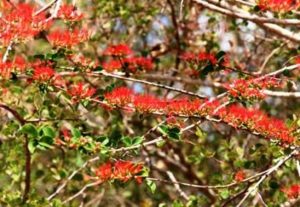
Combretum microphyllum. Photo: Petra Ballings. Source: Flora of Zimbabwe
Combretum microphyllum (Burning-bush Combretum) is one of the small number of red-flowered species. It is a spectacular climber, occurring in riparian habitats and forming clumps on alluvial soils; indeed it is often seen growing with C. mossambicense. It flowers en masse early in the season and is widespread generally at low altitudes in Zimbabwe.
Moving past Combretum bracteosum, which is a S African species with orange flowers, we came to Combretum imberbe (the Leadwood). Taxonomically, there is no problem here; this species has such a distinctive suite of characteristics: spiny branchlets, small grey leaves, black rough “crocodile” bark and relatively small fruits. As the name implies the wood is exceptionally heavy. It is a species of alluvium and many other associations.
We did not really have time to do justice to Combretum psidioides, which is a big climbing species with small fruits. We also glanced at the striking S African Combretum kraussii which has groups of white leaves.
Combretum elaeagnoides (Grey jesse-bush combretum) is a species of mopane woodland and also the jesse. The specific name refers to its similar appearance to shrubs of the genus Elaeagnus which also have leaves with silvery scales.
Terminalia is the other major common genus in Zimbabwe and is usually recognisable by its alternate (actually spirally arranged) leaves, often clustered at apixes of branches and its 2-winged fruits. Technically, it also differs from the other 3 genera in having no petals.

Terminalia prunioides. Photo: Bart Wursten. Source: Flora of Zimbabwe
- T. prunioides (Purple-pod terminalia) is a straightforward species, common in arid areas (and also riverine vegetation) at lower altitudes. The flowers, which were present on this occasion, occur in short lateral spikes. As the name suggests, the fruits are a strong purple colour.
- T. randii (Small-leaved terminalia) and T. stuhlmannii (Zigzag terminalia) always look rather similar to me. The Terminalia style of branching with a bare curved twig “looping” to the next rosette is very striking in these species. Both also may be spiny. However, T. randii has much smaller leaves and fruit and T. stuhlmannii usually has yellowish-green leaves. The concept of T. trichopoda has always been uncertain to me. Tom remarked that it is like “T. sericea tending towards T. stenostachya” and may even be a hybrid. FZ also records hybrids between T. sericea and T. trichopoda, so what we may have is a variable group with exact species depending on where the lines are drawn.
Terminalia gazensis (Fringe-leaf terminalia) is typical of higher rainfall areas such as the Shurugwi / Zvishavane areas or the dry side of Mutare (on Christmas Pass). The leaves have a noticeable hairy whitish fringe.
… To Be Continued. Mark Hyde
Greetings from John and Wendy Wilson
We wish all our friends in the Tree Society, a successful year ahead.
I have been meaning to tell you about our trip to Ireland a couple of months ago. We spent a few days in the Burren on the southern shores of Galway Bay. The Burren is an extensive deposit of limestone still in its horizontal layered form but greatly fissured – the fissures are richly endowed with plant life which evidently is wonderfully colourful in spring when flowering takes place. We were there in Autumn but even so the plant life in these cracks was impressive. The area is virtually treeless as the limestone is mostly exposed they say due to intensive farming there in ages past – all the soil has eroded away. I am talking about thousands of hectares as far as the eye can see.
Being limestone, the soil remaining in the fissures is very fertile. Furthermore, being on the west coast of Ireland rainfall is not scarce but the exposed rock picks up heat during the summer months which it releases slowly
into autumn and winter and so keeps the plants growing much later in their snug fissures than would be the case if they were exposed on the surface. The highly fissured rock is not unlike the sandstone outcrops of the lower Lundi region, which again had an interesting plant life. I am thinking of places such as Lonestar Ranch.
The area is rich in archeological issues as it was heavily populated before the soil was lost.
For the second part of our Irish stay we were in the Ring of Kerry in the south west. We were self-catering on a small dairy farm, Border Collies and all.
So I was in my element. It was blowing a gale and stormy. The house was haunted with bangs and knocking at the doors all night but nobody to let in ! I lay awake just wishing the apparition would show itself to me to prove the story for me to tell my grandchildren but dawn came without further molestation except that the garden furniture was strewn all over the place. A little bit of Sherlock investigatory work in the morning soon proved that each time the wind gusted, the letterbox in the front door rattled as if someone was frantic to get in. A piece of elastoplast soon obviated that. The rest of the disturbances was no more than effects of the stormy night, and my ghost story was not to be. Darn it ! But I loved Ireland, all the more.
Tam and family have just moved to the Sunshine Coast north of Brisbane and tell of horrendous temperatures, much greater than Rustenburg, their home for the last decade. I love the winter here. We remain well.
Love John and Wendy. (Wilson)
And Greetings from Paul Nel in the USA
Dear Mark, Maureen, Rob (My Teacher in what seems another lifetime) and fellow members (mother included),
To answer Marks request for contributions as well as to satisfy a personal yearning for home, I thought I would type a few lines on tree “life” here in Northwest Ohio.
From what must rank as one of your most distant members please accept that living in America now allows the privilege of abuse to the English language!
We now live what is known as the Oak openings region and whilst a majority of Ohio is flat farm land or industrial urban towns the Oak Openings is a beautiful strip of landscape where the soil changes create a multitude of different ecosystem’s occurring alongside one another. This is best seen in the Oak Openings Metro Park which far from our understanding of a park, is a 3743 acre nature reserve. Look at http://www.metroparkstoledo.com/metroparks/oakopenings/>) on the internet. Currently we are in the throws of early to mid winter where temperatures fluctuate between -10 an 10 degrees depending on the weather fronts. The oak landscape is stark and few trees have any leaves that remain. If one did not know the seasons here it is entirely possible to imagine the trees as being as lifeless as any Kariba stump. However having witnessed a full annual cycle of the seasons, I was flabbergasted by the transformation that occurs. I still do not know any of the tree names but come spring time when the trees start to blossom I realise there is greater variety than it first appears and I am not sure I want to start to learn the details over again. Besides there is something about Julbernardia globiflora etc. that I can’t find in an oak tree!
As mentioned in spring there are many beautiful flowering trees and after winter it is a new lease on life to walk amongst these and the giant oaks. Most of the animals are still visible and the heat is still bearable. This is usually short lived and last year we had four days between home heating being turned off and air con being switched on.
Spring quickly turns to summer and as rapidly the trees are fully covered making the forests a sea of green. The United States title of, “the land of plenty,” also extends to its tree life and this is most evident in mid summer. There are vast acres of trees here, more than I understood before I lived here, and in summer the thick green leaves give the impression that the forests are much more dense than what they actually are. During this time it is easy to forget how harsh life for the Indians must have been in winter because of the abundance of summer.
Fall comes along to check such day dreams!
I have been fortunate enough to travel extensively and some highlights include the USA canyons, (I can write on these another time), Namibia, Mana and the Zambezi in the early 80’s and many more, but, one of the very best is the Oak Openings in fall. It is impossible to describe this natural beauty and whilst I grew up with the Brachystegia (Masasa) colors there is no comparison. People say there are better places to see the fall colors but I find this adequate. It is truly a wonder of nature that is hard to explain or the capture on a photo. Unfortunately, it is not called fall for nothing and the as winter begins another annual cycle the once admired oak of summer becomes the pest in the back yard threatened with a chain saw as each leaf is dropped.
Anyway feeling a lot better now and after much pondering I have reached the conclusion that in the natural areas here the trees alone are more beautiful than back home in Zim. However, (Pronounced like Ruben Barwe) the bush is sterile, devoid of thorns and without the variety of butterflies/insects, birds and things that make our bush so unique.
Throw the people in and I wonder how I ever left! Regards, best wishes for 2006
and you are all always welcome in Maumee.
Paul Nel
Email: Paul.Nel@Dana.com
CHRISTMAS SOCIAL: 11TH NOVEMBER 2005
Our Christmas Social was once again, with the kind permission of Mrs Nobanda, the Director of the Botanic Gardens, held at the Education Centre at the National Botanic Gardens.
The day started well with us blowing a fuse (or in some way causing the electricity to vanish) and so some hurried re-planning took place (I went and fetched a gas cylinder) and tea-making resumed as before.
Later, the problem of how to display Rob’s PowerPoint slides without electricity was solved when JP fetched a neat portable generator, the beamer was connected up – and we were in business again!
We had a very good turnout with Tom as our special guest and a small presentation was made to him to thank him for his hard work during the year.
Entertainment was provided in a series of quiz questions devised by Rob and Adele, the latter sadly unable to attend. Were the questions perhaps a bit easier this year? I think so, but as chief scorer I was happily not being challenged intellectually – except with some simple addition.
Tom then led a walk in the Gardens, the second one in five days. I thought he might not be very pleased with this demand so quickly after the last but his usual good humour and willingness triumphed and we had a most interesting botanical interlude, within a few hundred metres of the Centre.
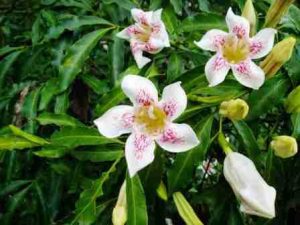
Rothmannia manganjae. Photo: Mark Hyde. Source: Flora of Zimbabwe
An interesting point was the Rothmannia manganjae, which was in such spectacular flower on 6th December had mostly gone over by the 11th. We also revisited the Millettia usaramensis which was still producing a most impressive display of purple flowers.
Our final formal event was not botanical. Rob Burrett had produced a series of images of small bits of Harare buildings, from which the teams were asked to identify the building itself. Naturally, this proved quite challenging; some of the pictures were quite extraordinary; but a lot of good fun was had trying to work them out.
All in all, it was an enjoyable day and a satisfying formal close to another year of the Tree Society’s activities.
As usual, we are most grateful to the Director of the Gardens, to Adele for her work on the quiz and especially to Rob for all the work he put in to giving us such a stimulating series of slides while at the same time showing us that there is much of interest all around us if we keep our eyes open.
-Mark Hyde
Footnote: Visit to Val D’Or
Strictly speaking the very last outing of the Society for 2005 was to Bill Clarke’s home on 31 December 2005. Those who attended will remember seeing a pale yellow-flowered orchid with flattened flowers in the woodland just below the dam wall. This has since been identified by Werner Fibeck as Eulophia ovalis subsp. bainesii. I gather it is not particularly unusual, but it was certainly new to me.
Mark Hyde
Historic Trees of Zimbabwe by Lyn Mullin
Books are still available from Maureen.
Leather bound copies $1 500 000
Hard covers $1 000 000
Soft covers $600 000
Wanted: articles for Tree Life …
TREE LIFE NEEDS YOU – or rather it needs your input. Articles, notes, comments, questions, observations – all are welcome.
Your contribution needn’t be long or weighty – a simple note or observation is often of great interest.
Don’t be put off by thinking you don’t know enough. Sit down and pen something today!
MARK HYDE CHAIRMAN


